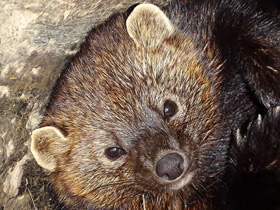The fisher (Pekania pennanti)
The fisher (Pekania pennanti) is a carnivorous mammal native to North America, a forest-dwelling creature whose range covers much of the boreal forest in Canada to the northern United States. It is a member of the mustelid family, and is in the monospecific genus Pekania. It is sometimes referred to as a fisher cat, although it is not a cat.
The fisher is closely related to, but larger than, the American marten (Martes americana) and Pacific marten (Martes caurina). In some regions, the fisher is known as a pekan, derived from its name in the Abenaki language, or wejack, an Algonquian word (cf. Cree ocêk, Ojibwa ojiig) borrowed by fur traders. Other Native American names for the fisher are Chipewyan thacho and Carrier chunihcho, both meaning "big marten", and Wabanaki uskool.
Description
Pekania pennanti or Martes pennanti is a species of carnivorous mammal in the family Mustelidae.
Pekania pennanti is one of the largest martens, measuring between 75 and 120 cm in body and tail and weighing between 2 and 5 kg. It is dark brown in colour, with darker legs and tail and silver fur on the head. The coat of the Pekania pennanti is thick and long, but coarse.
Taxonomy
The Latin specific name pennanti honours Thomas Pennant, who described the fisher in 1771. Buffon had first described the creature in 1765, calling it a pekan. Pennant examined the same specimen, but called it a fisher, unaware of Buffon's earlier description. Other 18th-century scientists gave it similar names, such as Schreber, who named it Mustela canadensis, and Boddaert, who named it Mustela melanorhyncha. The fisher was eventually placed in the genus Martes by Smith in 1843. In 2008, advances in DNA analysis allowed a more detailed study of the fisher's evolutionary history. The fisher and the genus Martes were determined to have descended from a common ancestor, but the fisher was distinct enough to put it in its own genus. It was decided to create the genus Pekania and reclassify the fisher as Pekania pennanti. Members of the genus Pekania pennanti.
Members of the genus Pekania are distinguished by their four premolar teeth on the upper and lower jaws. Its close relative Mustela has just three. The fisher has 38 teeth. The dentition formula is: 3.1.4.1/2.1.4.2
Habitat
Pekania pennanti is common in the forests of North America, from the Sierra Nevada Mountains of California to the Appalachian Mountains of West Virginia, preferring to stick to coniferous forests with an abundance of understory trees. Pekania pennanti usually makes its home in spruce, pine, thuja and some deciduous trees. In winter they tend to settle in burrows, which they sometimes dig in the snow. Ilkies are agile tree climbers, but often move on the ground. They are active 24 hours a day and are solitary.
Nutrition
Contrary to its name, the Pekania pennanti rarely feeds on fish. Their favourite prey are forest porcupines, as well as mice, squirrels, squirrel hares, birds and shrews. Ilkies also eat berries and fruits, such as apples. Ilkies can easily chase prey both in trees and in burrows.
Reproduction
The mating period of Pekania pennanti occurs between late winter and early spring. Pregnancy lasts 11-12 months, of which 10 months are spent in diapause and the embryo does not develop. The brood of Pekania pennanti consists of up to 5 blind and almost naked young. They become independent in the fifth month. Shortly after giving birth, the females mate and become pregnant again.
Pekania pennanti have a lifespan of up to 10 years.
Relationship with humans
Fishers have had a long history of contact with humans, but most of it has been to the detriment of fisher populations. Unprovoked attacks on humans are extremely rare, but fishers will attack if they feel threatened or cornered. In one case, a fisher was blamed for an attack on a six-year-old boy. In another case, a fisher is believed to be responsible for an attack on a 12-year-old boy.
Captivity
Fishers have been captured live for fur farming, zoo specimens, and scientific research. From 1920–1946, pelt prices averaged about C$137. Since pelts were relatively valuable, attempts were made to raise fishers on farms. Fur farming was popular with other species such as mink and ermine, so the same techniques were thought to be applicable to fishers. However, farmers found it difficult to raise fishers due to their unusual reproductive cycle. In general, knowledge of delayed implantation in fishers was unknown at the time. Farmers noted that females mated in the spring but did not give birth. Due to declining pelt prices, most fisher farms closed operations by the late 1940s.
Fishers have also been captured and bred by zoos, but they are not a common zoo species. Fishers are poor animals to exhibit because, in general, they hide from visitors all day. Some zoos have had difficulty keeping fishers alive since they are susceptible to many diseases in captivity. Yet at least one example shows a fisher kept in captivity that lived to be 10 years old, and another living to be about 14 years old, well beyond its natural lifespan of 7 years.
In 1974, R.A. Powell raised two fisher kits for the purpose of performing scientific research. His primary interest was an attempt to measure the activity of fishers to determine how much food the animals required to function. He did this by running them through treadmill exercises that simulated activity in the wild. He compared this to their food intake and used the data to estimate daily food requirements. The research lasted for two years. After one year, one of the fishers died due to unknown causes. The second was released back into the wilderness of Michigan's Upper Peninsula.
Interactions with domestic animals
In some areas, fishers can become pests to farmers when they raid chicken coops, and instances of fishers preying on cats and small dogs have been reported. However, a 1979 study examined the stomach contents of all fishers trapped in the state of New Hampshire; cat hairs were found in only one of over 1,000 stomachs. An informal unfinished 2011 study in suburban upstate New York found no cat remains in 24 scat or stomach samples, and an earlier published study found no cat in 226 Massachusetts samples.

















































